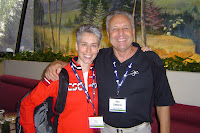NSCA Atlanta: A Great Experience
 I am so happy I decided to attend the NSCA conference in Atlanta. Not so much for the conference itself, but more so for the people who were there. Met some new people, revitalized old friendships and had the chance to talk to several mentors and colleagues. Highlights included dinner with Jerry Mayhew and Alex Koch of Truman State (nothing like drinks in ceramic coconuts!), the poster session and early-morning training sessions with all of the ETSU grad students (Mike and Meg Stone students), training and gabbing at Bud Charniga's Dynamic Fitness booth with Bud, Lou DeMarco and John Garhammer, chatting with Victor Bergonzoli and my Dartfish peeps, and of course, coffee talk with Jedi Masters Vern and Mrs. Vern.
I am so happy I decided to attend the NSCA conference in Atlanta. Not so much for the conference itself, but more so for the people who were there. Met some new people, revitalized old friendships and had the chance to talk to several mentors and colleagues. Highlights included dinner with Jerry Mayhew and Alex Koch of Truman State (nothing like drinks in ceramic coconuts!), the poster session and early-morning training sessions with all of the ETSU grad students (Mike and Meg Stone students), training and gabbing at Bud Charniga's Dynamic Fitness booth with Bud, Lou DeMarco and John Garhammer, chatting with Victor Bergonzoli and my Dartfish peeps, and of course, coffee talk with Jedi Masters Vern and Mrs. Vern.The biggest news for me, was finding out my proposal to speak at next year's conference has been accepted! Huge challenge and great opportunity for me to present my ideas on rethinking back health and performance. Hope to see/meet many of you next year in Las Vegas!
My biggest beef with the conference was the Verstegen/Hopson/PowerPlate presentation, titled "A Painless Path to Optimal Performance." Now, nowhere in this title, on the NSCA website, or in the NSCA conference handbook of handouts was there ANY detail of what this talk was really about. It was all about PowerPlate and vibration training. And how convenient Mr. Hopson is a bigwig for PowerPlate. Mr. Hopson began his talk by divulging his position and apologizing for not having handouts, but did tell us we could pick them up at his booth (#159!) and get them online. Well, as of today, the notes are not on the NSCA ftp site. I walked out of this baloney and refused to go to the booth to get the notes. I found this all very slimy, and afterwards had the opportunity to talk to an NSCA conference committee member and told him of my concerns.
Don't get me wrong, I have been to Athlete's Performance and met Mark. He's done some impressive work and utilizes PTs well in his system. I would've been open to hearing his experience with vibration training. I just think the NSCA and all speakers should be compelled to provide full disclosure well in advance of the talk--in all web and print materials. And if one speaker needs to have his outline in by May 1, then they all need to have them in. I believe this was the only handout not included in the book.
My second concern is the lack of quality presentations regarding use of weightlifting (ack Olympic lifting!) movements. Any presentation that involves aspects of teaching the lifts should be very visually intensive and with demonstration. Text alone just doesn't get it, especially when there are therapists and new trainers in the audience who have no idea what this stuff is all about. Maybe I'll propose a weightlifting "From the Field" demo for next year specifically for newbies. And please, if anyone needs some video or still pics of weightlifting stuff, please let me know! I can help you.
It is always interesting to walk the path among the hard core strength/weightlifting people and the functional training/rehab people. Do not shut your head off to either; but realize there are limitations to both. Weightlifting movements are not the answer to all strength needs, but there are basic elements from weightlifting that can help anyone create sound body awareness, motor patterns, mobility and strength that are essential to everyday function.
Life is a banquet of multi-planar movement challenges, served up daily by our omni-present host, gravity. To survive and thrive, we must develop a physical literacy--a movement/biomotor vocabulary--that combines the elements of awareness, alignment (postural integrity), mobility, strength and power. This physical literacy results from deliberate practice and rehearsal, and is an emergent system that is more than just the sum of its parts. If we attempt to describe, measure, define or act on it via only one sub-level (say, strength), without the context of gravity, the entire body or purpose of task, then we miss the point.
-Tracy Fober

Comments
The only thing we can learn from them is how not to act.